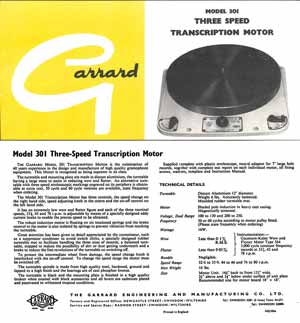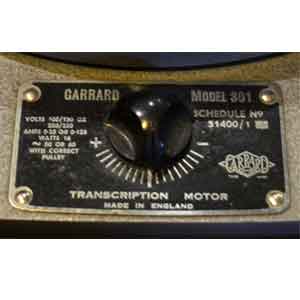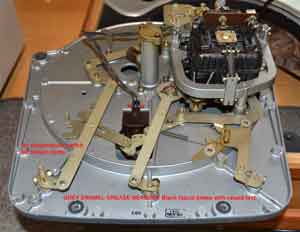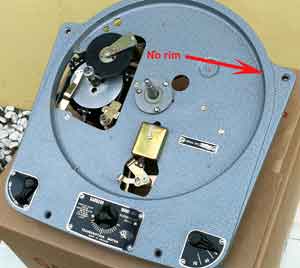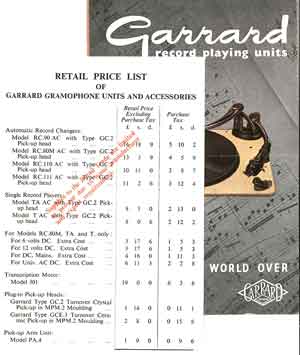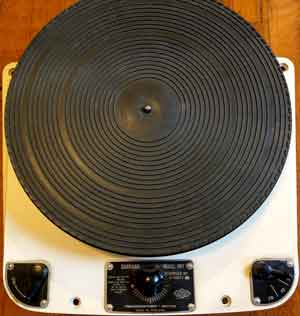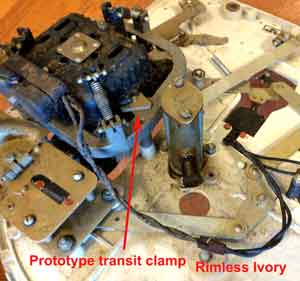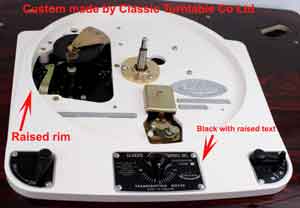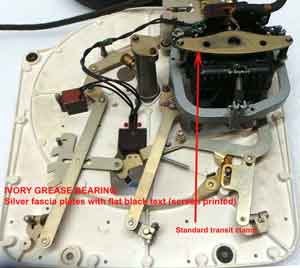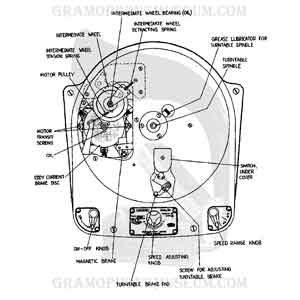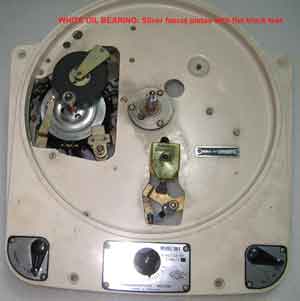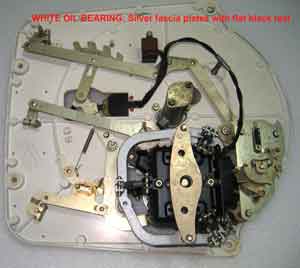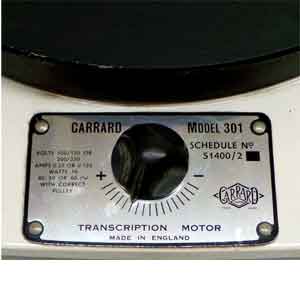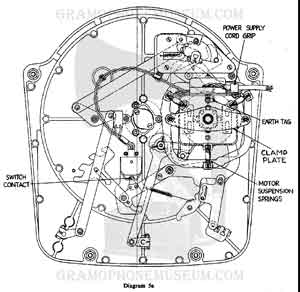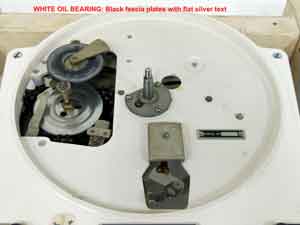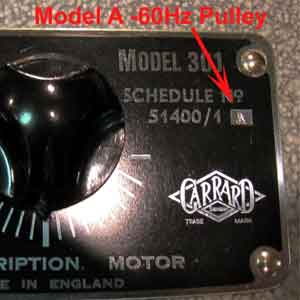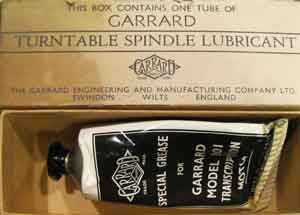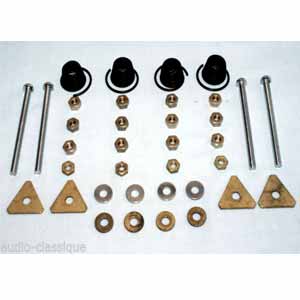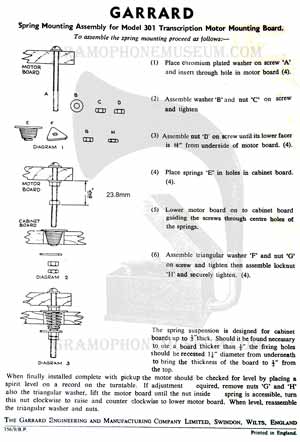Garrard 301. The Classic Transcription Turntable
Garrard 301: 1953-1965. Transcription turntable developed by Edmund W. Mortimer.
Prices.
- 1954: £19 + £6. 3s. 6d tax
- 1959: £16. 17s. 6d + £5. 9s. 9d tax. With strobe turntable: £18. 1s. 0d + £5. 17s. 4d
- 1962: £17. 14s. 6d + £5. 3s. 9d tax. With strobe turntable: £18. 19s. 3d + £5. 11s. 0d
The iconic Garrard 301 transcription turntable is revered the world over. Its successor the Garrard 401 is by all accounts sonically superior but the classic design of the 301 outshines the 401. Audio buffs mock the idle wheel mechanism, it’s so much noisier compared to the belt drive and even some very high-end direct drive turntables, but to fans, that is what gives the 301 it's unique sound and character.
The Garrard 301 was the first transcription turntable that played at 33 ⅓, 45 and 78 rpm speeds. It was robust, minimalist and beautifully built. It featured a 4 pole Garrard Induction motor driving an idle wheel which drove the platter from inside its rim. The chassis and platter were made from diecast aluminium and weighed 16 pounds - 6 pounds of which was the platter. The platter was balanced and freely spun on a high precision bearing.
Production of the 301 started in 1953; it hit the market in 1954. The 301 was usually sold without a plinth, tonearm or cartridge. The strobe-rim platter was around a £2 extra-cost option.
There were two schedules of the Garrard 301.
- Schedule 1 (51400/1): 1953-1957 Grease bearing
- Schedule 2 (51400/2): 1957-1965 Oil bearing
The manual specifications remained the same throughout.
- Voltage: Dual range 100-130v and 200-250v (The actual current required varied slightly from early to later motors.)
- Frequency: 50Hz (nickel) or 60Hz (brass) according to motor pulley fitted.
- Wow: Less than 0.02%
- Flutter: Less than 0.05%
Differences in production. The Garrard 301 remained little changed other than paint colour, and the switch/speed plates. One major early change was, a stiffening ridge was added to the cast chassis creating a rim on the chassis at the periphery of the platter.
Grey enamel “hammertone” paint. This is a textured paint used to hide imperfection in metal. It is suggested that the grey 301’s were made from melted down bombs and other armament surplus from WW2. A lot of the hammertone 301’s went to the BBC who were not bothered about the finish but happy about the reduced price.
All grey 301’s are rimless. They do not have a rim on the inside edge of the chassis where the turntable sits. During the crossover period to Ivory 301’s, when high quality aluminium was available again; a small number were made using the rimless mould. These are the rarest of the Garrard 301’s. They turn up around the mid 15000 serial numbers. All other 301’s have a rim.
Sometimes they are marked with a model. “A” and “2” have been spotted. "A" model. Refers to a 120v and a 60Hz brass pulley made for the American market.
Transit clamp: Apart from the grey 301’s all others have transit clamps with red screw heads viewable under the turntable near the idle wheel. As the name suggests they are only for clamping the heavy motor while in transit and should be completely loosened before levelling and setting up the turntable. Some audio buffs completely remove the transit clamp, claiming it's weight and springs may cause noise.
- GREY ENAMEL GREASE BEARING: Black fascia plates with raised text. Earliest model. Early motor with more torque than later models, this early motor also requires slightly less current, (190 to 200v & 95 to 100v), which would suggest less noise; perhaps why they are so popular in Japan (90-100v). Some early ones do not have a switch suppressor unit and the eddy current brake disc is almost flat. Generally accepted that the serials numbers run up to the 15,000’s.
- IVORY GREASE BEARING: Black fascia plates with raised text. As above with rimless chassis. Earliest ones also feature a prototype transit clamp with triangular washers and red screw heads, soon replaced with the standard T-shaped transit clamp. These are quite rare but do turn up more often in the USA because of exports. Serial numbers start around the mid 15,000’s.
- IVORY GREASE BEARING: Black fascia plates with raised text. New moulded chassis with rim. Do these exist? The only ones spotted are modern custom made units.
- IVORY GREASE BEARING: Silver fascia plates with flat black text (screen printed). Produced up to 1957. New moulded chassis with rim. The motor current was 200 & 100 volts. Also have the new transit clamp with T-plate and red screw heads. Estimated serial numbers running from around 20,000. (Internet source with receipt: serial # 21055, bought new on the 20/9/57).
- IVORY OIL BEARING: Silver fascia plates with flat black text. Post 1957. As above but with new oil bearing. Estimated serial numbers running from around 35,000.
- WHITE OIL BEARING: Silver fascia plates with flat black text. As above. Estimated serial numbers running from around 50,000.
- WHITE OIL BEARING: Black fascia plates with flat silver text. Last version. Later motor (215v & 107v). More suited for today’s 230V in the UK. Fitted with a Mu-metal switch cover. Estimated serial numbers running from around 70,000 to highest serial number known so far, 82,168.
Dating a Garrard 301
is based on a bit of guess work but this method may give an approximate date. Most sources on the internet use 7000 as a mean number for per year sales. (So, a serial number 12345 divided by 7000=1.76; +1954= late 1955. The highest serial number spotted, 82,168, would put it in late 1965).
Here is a site to date your 301 or 401 by it's serial number: Garrard 301/401 serial number decoder
It has to be kept in mind that when turntables were returned to Garrard for repair, they may well have added the slight improvements to early turntables. Also, over the years, Garrard 301’s have been extensively renovated and upgraded, by individuals and companies specializing in these upgrades. It’s a rare thing to come across an un-tampered with 301.
Restoration and Upgrades
Garrard 301’s are very highly regarded by Hi-Fi enthusiasts. The rarer grease bearing versions demanding very high prices. To keep these turntables performing at their best, regular maintenance and care is vital. Fortunately there are several sources of replacement parts, original and upgrade quality.
Restoring to original specifications is relatively simple. The following parts usually need to be serviced or replaced:
- Idle wheel. Any dirt or the tiniest imperfection will cause noticeable problems. Never leave it engaged to the motor pulley
- Springs: Delicate return, motor suspension & chassis mounting springs
- Service bearings
- Cleaning & gentle oiling. (Do not use solvents, over time, they may cause flaking. No to 3-in-1 oil which will in time go sticky).
- Electrical checks for insulation and leakage. (Heat shrink tubing is a great idea)
Upgrading: There are all sorts of upgrades, here are only a few.
- Modern replacement idle wheels
- Replacing the motor with the improved Garrard 401 motor
- Custom built super precision bearings
- Dedicated power supply
There are several firms that undertake serious upgrading of the Garrard 301. Loricraft Audio used to be the leader. They now run under the name of Garrard Turntables UK Ltd.
Here is a “drooling” page on the Garrard 301. The Garrard Project 2015: From Simple to Spectacular! by Jeff Day
